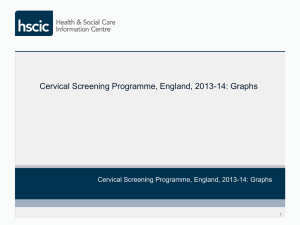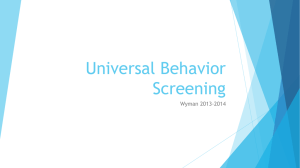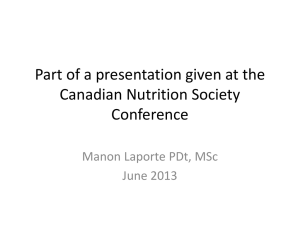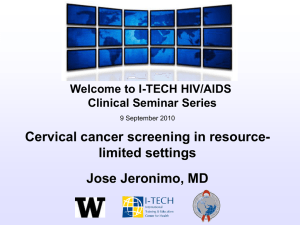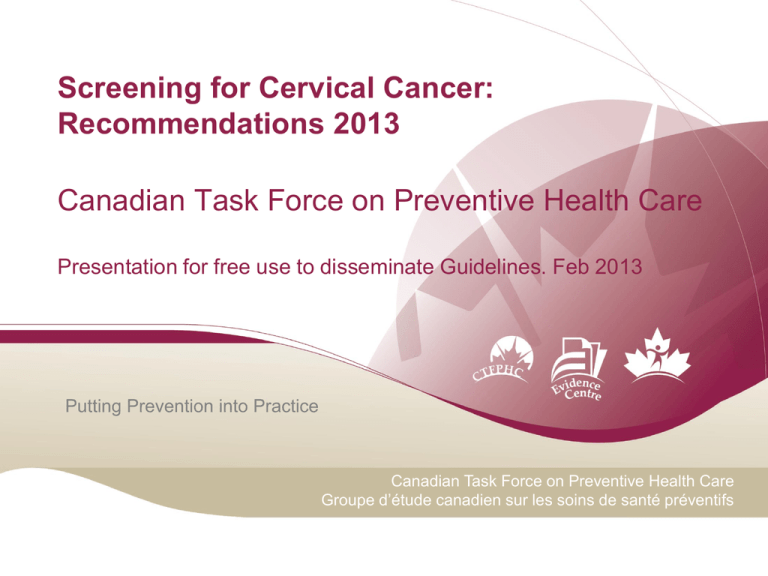
Screening for Cervical Cancer:
Recommendations 2013
Canadian Task Force on Preventive Health Care
Presentation for free use to disseminate Guidelines. Feb 2013
Putting Prevention into Practice
Canadian Task Force on Preventive Health Care
Groupe d’étude canadien sur les soins de santé préventifs
CTFPHC Cervical Cancer Working Group Members
Task Force Members
• Dr. James Dickinson (Chair)
• Dr. Marcello Tonelli
• Dr. Richard Birtwhistle
• Dr. Gabriela Lewin
• Dr. Michel Joffres
• Dr. Elizabeth Shaw
• Dr. Harminder Singh
Pan-Canadian Cervical Cancer
Screening Initiative (PCCSI)
• Dr. C. Meg McLachlin
• Dr. Verna Mai
Evidence Review and
Synthesis Centre:
• Donna Fitzpatrick-Lewis*
Public Health Agency:
• Eva Tsakonas*
• Dr. Sarah Connor Gorber*
*non-voting member
2
Background
• This guideline (2013) updates previous CTFPHC
cervical cancer screening guidelines (1994).
• 1994:
<20 years
20 to 69 years
Annual screening with
cervical cytology following
initiation of sexual activity, or
at age 18 years.
After 2 normal Pap smears,
screening recommended
every 3 years (frequency
may be increased in
presence of risk factors).
70+ years
Routine screening not
recommended.
• Much of the profession continued annual screening
3
Goal of the 2013 Guideline
• To provide recommendations for the prevention of
cervical cancer related morbidity and mortality.
• To clarify the age of screening initiation, cessation
and the optimum screening interval.
• To form the recommendations on an updated
systematic review of the literature and the current
epidemiology and diagnosis of the disease in
Canada.
4
Evidence Search
Searched for studies of Cancer incidence and
mortality reduction
NOT intermediate outcomes
– LSIL, HSIL
– CIN2, 3
– HPV infection
• Unclear (but high) proportion regress
• Small proportion progress, unclear time scale
5
New Understanding of Cervical Cancer
• Biology
• Balance of harms/benefits
• Canadian changes in epidemiology
• Lifetime probability of Death or Incidence
1952
1972
2002
Mortality
0.94
0.66
0.22
Incidence
Not known
1.54
0.66
6
Current Epidemiology of Cervical Cancer
1200
16
14
Incidence
No. of women
800
Cases of
cervical cancer
12
10
600
Mortality
8
6
400
4
Rate per 100 000 women
1000
200
2
Deaths from cervical cancer
0
0
15-19 20-24 25-29 30-34 35-39 40-44 45-49 50-54 55-59 60-64 65-69 70-74 75-79 80-84
Age group (years)
Canadian Task Force on Preventive Health Care. Recommendations on screening for cervical cancer. CMAJ 2013 Jan 8; 185(1):35-45
7
The Natural History of HPV Infection
and Cervical Cancer
Normal
cervix
Viral persistence
and progression
HPV-infected
Precancerous
cervix
lesion
Regression
Clearance
Cancer
Invasion
HPV
Precancer
15 yrs
Cancer
30 yrs
45 yrs
Pap tests
HPV vaccination
HPV test 1
HPV test 2
Adapted from Schiffman M, Castle PE. The promise of global cervical-cancer prevention. NEJM 2005; 353(20):2101-4
8
Abnormal Smears by Age: Percent (%)
20-29 30-39 40-49 50-59 60-69
Abnormal
9.8
4.5
3.5
2.4
1.6
ASC-H
0.4
0.2
0.1
0.1
0.1
HSIL+
1.1
0.6
0.3
0.2
0.1
2006-2008 From Cervical Cancer Screening in Canada
Monitoring Program Performance - Report
9
Mortality from Invasive Cervical Cancer
in Canada in Periods from 1972 to 2006
30
28
26
24
1972-1976
Rate per 100,000
22
1977-1981
20
18
1982-1986
16
1987-1991
1992-1996
1997-2001
14
12
10
2002-2006
8
6
4
2
0
15-19 20-24 25-29 30-34 35-39 40-44 45-49 50-54 55-59 60-64 65-69 70-74 75-79 80-84
Age group (years)
10
Different Approach to Assessment
• From:
– Is preventive maneuver effective?
• To:
– Is it a good decision for the person?
More patient-centered approach
11
Change in Approach
GRADE method
GRading of
Assessment
Development and
Evaluation system
12
Decision Balance
Benefits
Reduced risk of death
Reduced morbidity
Harms
Complication of treatment
Over-diagnosis
Anxiety
13
Emerging Evidence of Harms
• Cone biopsy/treatment
• Cervical incompetence: double risk
– Early pregnancy loss
– Premature labour
• Cervical scarring: cannot dilate
• Affect young >> completed families
14
GRADE Outcome
Strength of evidence
• Based on quality of study design, implementation
• Strength of effect
• Consistency
• External validity
How confident that evidence correctly reflects true effect of service?
THEN
Strength of recommendation
• Balance of evidence for harm vs benefit
• Uncertainty or variability in values and preferences
• Use of resources
15
GRADEs of Recommendation
Strong recommendations
– Most individuals in this situation would want the
recommended course of action.
– Most individuals should receive the intervention
– Adopt as policy
Weak Recommendations
– The majority of individuals in this situation would want the
suggested course of action,
– Different choices will be appropriate for individual patients
and clinicians must help each patient arrive at a
management decision
– Policy-making will require substantial debate
16
Cervical Screening
• Change in recommendations
• GRADE approach
• Decisions reflect continuous change in evidence with age
Strong: screen
Weak: do
Weak: not
Weak: do
Weak: not
Strong: not
17
Screening for Cervical Cancer
RECOMMENDATIONS
18
Considerations
These recommendations apply to women who:
– are 15+ years of age;
– are asymptomatic for cervical cancer; and who
– are or have been sexually active.
These recommendations do not apply to women:
– who do not have a cervix (due to hysterectomy) No screening
needed
– who have limited life expectancy such that they would not benefit
from screening.
– with symptoms of cervical cancer (e.g., abnormal cervical bleeding)
– who are immunosuppressed (e.g., organ transplantation)
19
Summary of the recommendations
• For a balance of potential benefits and harms, the CTFPHC
recommends screening asymptomatic women aged 25-69 with
cytology (Pap test) every 3 years.
• Cytology screening is recommended (conventional or liquidbased, manual or computer-assisted).
• We decided to make no recommendation on Human
Papillomavirus (HPV) testing (alone or in combination with Pap).
• Evidence was summarized, and recommendations made, for
age groups:
– <20 yrs; 20 to 24 yrs; 25 to 29 yrs; 30 to 69 yrs; 70+ yrs
20
Findings: women <20 years
Evidence of screening effectiveness
– No evidence found for effectiveness in women <20 years.
• Used epidemiological estimates to determine potential
benefit of screening.
• Incidence is very low with no deaths from cervical cancer
in Canada from 2002-2006.
• Therefore cannot reduce it further!
Evidence of harms of screening
– No national data on prevalence of abnormal findings in this
age group.
– Data from AB show that 10% of women screening <20 years
referred for colposcopy (potential for harms)1.
1. Towards Optimized Practice Program. Guideline and screening for cervical cancer.
http://www.topalbertadoctors.org/download/587/cervical+cancer+guideline.pdf. Updated 2011. Accessed 04/20, 2012.
21
Recommendation: women <20 years
• For women aged <20 years, we recommend
not routinely screening for cervical cancer
(strong recommendation; high quality evidence)
• This recommendation is based on:
–
–
–
–
Very low incidence of cervical cancer and no deaths due to cervical cancer
No studies addressing effectiveness in this age group; and
Evidence of minor harms to 10% of those screened
Some may develop more severe harms later:
• Potential pregnancy losses subsequent to cervical treatment.
• Strong recommendation reflects judgment of the CTFPHC that the
potential harms outweigh the benefits.
22
Findings:
women 20 to 24 years, and 25 to 29 years
Evidence of screening effectiveness
– No evidence on effectiveness of screening on mortality.
– UK study found incidence of cervical cancer in women up to
age 30 was not affected by screening women aged 20-241.
– No reduction in mortality in Canada among women 20-24 years
since 1970s2.
Evidence of harms of screening
– Specificity for pre-cancer lesions lower & risk of false-positives
higher for <30 years.
– High incidence of minor harms3 and pregnancy-related harms.
– Potential for early pregnancy loss or premature labour (after
cervical treatment).
1. Sasieni P, Castanon A, Cuzick J. Effectiveness of cervical screening with age: population based case-control study of prospectively
recorded data. British Medical Journal. 2009;339:b2968.
2. Canadian Cancer Registry (1992-2006) and the National Cancer Incidence Reporting System (1972-1991)
3. TOMBOLA (Trial of management of borderline and other low-grade abnormal smears), Sharp L, Cotton S, Cochran C, et al. After-effects
reported by women following colposcopy, cervical biopsies and LLETZ: Results from the TOMBOLA trial. International Journal of Obstetrics
and Gynaecology. 2009;116:1506.
23
Recommendation: women 20 to 24 years
• For women aged 20 to 24 we recommend
not routinely screening for cervical cancer
(Weak recommendation; moderate quality evidence)
• This recommendation is based on:
– low incidence and mortality of cervical cancer among this age group;
– uncertain benefit of screening among this age group;
– lack of benefit found in older ages from screening at this age;
– higher risk of false positive tests (and associated harms) among
women <30 compared to older women.
• The CTFPHC conclude that the harms outweigh the benefits, but assign
a weak recommendation given the uncertainty of the evidence.
24
Recommendation: women 25 to 29 years
• For women aged 25 to 29 we recommend routine
screening for cervical cancer every 3 years.
(Weak recommendation; moderate quality evidence)
• This recommendation is based on:
– higher incidence and mortality of cervical cancer in this age group;
– however, the limitations to Pap testing are similar to those among
20-24 year olds
• Weak recommendation reflects concerns about:
– the rate of false positives; and
– the harms of overtreatment
25
Findings: women 30 to 69 years
Evidence of screening effectiveness
– Strong association between introduction of screening and reduced incidence
of cervical cancer (cohort studies).
– RCT in rural India showed that 1-time screening found non-significant impact
on 8-year mortality and incidence (external validity?).
– Screening associated with decrease in incidence (cohort study, 3-yr follow-up).
– Odds of having 1+ Pap tests were lower among women with invasive cancer
(meta-analysis of 12 case-control studies).
Evidence of harms of screening
– Abnormal findings and high grade lesions declined with age1.
– Rate of biopsy/treatment decrease with age.
– Pregnancy-related harms become less important.
1. Canadian Partnership Against Cancer. Cervical cancer screening in Canada monitoring program
performance - report 2006-2008. 2011.
26
Recommendations: women 30 to 69 years
• For women aged 30 to 69 we recommend routine
screening for cervical cancer every 3 years.
(Strong recommendation; high quality evidence)
• This recommendation is based on:
– evidence for the positive effect of screening;
– higher cervical cancer incidence and mortality in this age group; and
– lower rates of potential harms, compared to younger women.
• Strong recommendation based on the CTFPHC’s confidence that
desirable effects of screening outweigh the undesirable effects.
27
Findings: women 70+ years
Evidence of screening effectiveness
– Limited evidence re: when to stop screening.
– Limited evidence suggests protective effect of screening
in women 70+1,2
– Mortality and incidence rates of cervical cancer remain high
in this age group (Canada).
– Possible benefit in screening if not adequately screened
previously.
1. Andrae B, Kemetli L, Sparén P, et al. Screening-preventable cervical cancer risks: Evidence from a nationwide audit in Sweden.
Journal of the National Cancer Institute. 2008;100:622.
2. Hoffman M, Cooper D, Carrara H, et al. Limited pap screening associated with reduced risk of cervical cancer in South Africa.
International Journal of Epidemiology. 2003;32:573.
28
Recommendations: women 70+ years
• For women aged ≥70 adequately screened (i.e. 3 successive
negative Pap tests in last 10 years), we recommend that
routine screening may cease.
(Weak recommendation: low quality evidence)
• Recommendation based on:
– Limited evidence that screening up to this age prevents cervical
cancer development therafter; fewer harms in this age range, but
speculum exam may be uncomfortable/difficult.
• For women aged ≥70 not adequately screened, we recommend
continued screening until 3 negative test results have been
obtained.
(Weak recommendation: low quality evidence)
• Recommendation places high value on:
– Limited evidence for screening effectiveness; and potential to detect and
treat cervical cancer in this age group
29
Recommended screening interval: 3 years
• Screening intervals ≤5 years offer protection
– 13 case-control, 2 cohort studies
• Greater benefit seen in shorter intervals in some of the studies.
• CTFPHC recommends 3 year interval;
– balances potential for benefit from smaller intervals, with
– greater potential for harm from more frequent screening
• Most countries outside North America use 3-5 year intervals
30
Protective efficacy by duration since last smear
Relative risk
Age 20-39 years
Age 40-54 years
Age 55-69 years
5.0
5.0
5.0
2.0
2.0
2.0
1.0
1.0
1.0
0.5
0.5
0.5
0.2
0.2
0.2
0.1
0.1
0.1
0
1
2
3
4
5
6
Years since last negative smear
0
1
2
3
4
5
6
Years since last negative smear
Sasieni P, Adams J and Cuzick J. Br J Cancer. 2003 Jul 7;89(1):88-93
0
1
2
3
4
5
6
Years since last negative smear
31
Summary of the recommendations (1)
Cytology (conventional or liquid-based, manual or computerassisted)
• For women aged <20, we recommend not routinely screening
for cervical cancer
(Strong recommendation; high quality evidence)
• For women aged 20 to 24, we recommend not routinely
screening for cervical cancer
(Weak recommendation; moderate quality evidence)
• For women aged 25 to 29, we recommend routine screening
for cervical cancer every 3 years.
(Weak recommendation; moderate quality evidence)
32
Summary of the recommendations (2)
• For women aged 30 to 69, we recommend routine screening
for cervical cancer every 3 years.
(Strong recommendation; high quality evidence)
• For women aged ≥70 who have been adequately screened
(i.e. 3 successive negative Pap tests in the last 10 years), we
recommend that routine screening may cease. For women
aged 70 or over who have not been adequately screened, we
recommend continued screening until 3 negative test
results have been obtained.
(Weak recommendation; low quality evidence)
33
Special risk groups?
Many suggested high risk groups
–
–
–
–
Start sexual activity young
Multiple partners
Aboriginal
Attending STI clinics
Minimal evidence: no specific recommendations
Women sex with women
– Limited evidence that they are at risk
34
Duration from onset of sexual activity
NO evidence
35
“Jade Goody” effect
Starting screening early?
– Rapidly advancing cancer among young women
– Screening works for chronic, common
disease
• Must be treatable: criteria for screening
– Little effect for patients under 25:
• Rapidly advancing but rare
– Adenocarcinoma: unclear whether increasing
36
Response to anecdotes re young women
Women whose “lives were saved” by a pap test in teenage or
young 20s
• Cancer very rare at these ages, but possible
• Majority likely to have been high grade abnormalities, not cancer
• Most would have regressed if left alone:
– “HPV infection defeated by immune system”
– High grade abnormality rate much higher than lifetime cancer risk
• Small, if any, preventive effect for young
• Some rapidly advancing cancers:
– screening and treatment ineffective
• Balance of very small benefit against harms of treatment
• GRADE approach recognizes different opinions about balance
37
“Yes but…” questions.
What about:
Chlamydia screening?
Vaginal examinations?
Teaching annual physicals?
• Chlamydia screening by urine testing
• Vaginal exams poor screening test for ovarian,
uterine cancer
• Should not do annual physicals:
– periodic health assessment
38
Screening for Cervical Cancer
WHAT ABOUT HPV TESTING?
39
The CTFPHC Position on HPV Testing
• Search for studies showing lower incidence/mortality of cancer
• The CTFPHC felt it premature to make a recommendation on
HPV testing alone (primary testing), or in combination with
cytology (co-testing or as a secondary reflex triage test).
• Canadian Partnership Against Cancer (CPAC):
– HPV Testing for Cervical Cancer Screening
– Expert panel: summary of evidence
– 29 March 2012
• Summarized that the evidence is still unclear and to proceed
cautiously
40
HPV testing: Canada
• Ontario
– Primary HPV screening is recommended and implementation is
being considered.
• May 2012 cervical screening guideline, initiated by the Ontario
Cervical Screening Program in conjunction with the Program
in Evidence-based Care, an initiative of Cancer Care Ontario.
– For the interim, cytology recommendations are in place including
an additional HPV testing (triage) as an optional test for women
30 years and older with certain abnormal Pap test results.
• Alberta, Quebec and NWT recommend triage testing
41
HPV testing: International
• Australia and Scotland: No recommendation on HPV testing
• US Task Force on Preventive Health Care (USPSTF)
– For women ages 30 to 65 years who want to lengthen the screening
interval, screening with a combination of cytology and human
papillomavirus (HPV) testing every 5 years (co-testing with Pap)
– Needs further evaluation in long-term trials
• Whitlock et al. Ann Int Med 2011; 155:687-97
• England: Triage testing for 25 years and older.
• Netherlands: recommendation for primary HPV testing, but
as a triage test if cytology is used.
42
Considerations for implementation of
recommendations (1)
• Emphasis should be placed on strong vs. weak recommendations
Women who:
– place relatively higher value on avoiding cervical cancer
and
– relatively lower value on potential harms/benefits
Are more likely to choose screening
• There should be increased/decreased screening by risk profile.
• Values, preferences and beliefs
– Should be discussed in context of potential benefits/harms of screening process
– Clinicians should help patient make a decision consistent with her values,
preferences and risk exposure
43
Considerations for implementation of
recommendations (2)
• Current recommendations vary by P/T. Most currently begin
screening at age 21, cease at age 70, and have a 1-3 year
screening interval.
– Some P/T have recently updated their guidelines
– Some P/T make recommendations on HPV testing
44
Screening for Cervical Cancer
GUIDELINE COMPARISON:
International
45
CTFPHC vs. International Guidelines (1)
Organization
Task Force
2012
Canada*
Previous Task
Force (1994)
Canada
USPSTF 2012
United States
<20 years
20-24 years
Recommend
against
routine
screening
Recommend
against routine
screening
Annual
screening with
cervical
cytology
following
initiation of
sexual activity
or at age 18
Recommend
against
routine
screening
under the age
of 21
25-29 years
Recommend
routine screening
every three years
with cervical
cytology
30-69 years
Recommend
routine screening
every three years
with cervical
cytology
70+ years
HPV testing*
Recommend routine
screening every three
years with cervical
cytology if inadequately
screened. Otherwise
screening may cease.
No recommendation
made. Will revisit the
issue of HPV testing as
new data becomes
available.
After 2 normal Pap tests, screening then recommended every
three years to age 69. Frequency of screening may be
increased in the presence of risk factors
Screening not
recommended
Not applicable
Recommend against routine screening under the age of 21
Recommend against
screening for cervical
cancer in women older
than age 65 years who
have had adequate prior
screening and are not
otherwise at high risk for
cervical cancer
For women ages 30 to
65 years who want to
lengthen the screening
interval, screening with
a combination of
cytology and human
papillomavirus (HPV)
testing every 5 years
(co-testing)
Recommend screening for cervical cancer in women ages 21
to 65 years with Pap test every 3 years
Recommend against screening for cervical cancer in women
older than age 65 years who have had adequate prior
screening and are not otherwise at high risk for cervical
cancer
* Recommendations for primary (HPV testing alone), co-testing (with Pap test), or triage/reflex
testing (after abnormal Pap test) were considered
46
CTFPHC vs. International Guidelines (2)
Organization
Australian
Government
Australia
(May 2011)
NHS Cervical
Screening
Program
<20 years
20-24 years
25-29 years
30-69 years
70+ years
First Pap test
around age 18
to 20, or a year
or two after first
having sex,
whichever is
the later
Regular Pap tests recommended every two years
Practitioner may advise
that it is safe to stop having
Pap tests if previous tests
have been normal
No recommendation
made
Not invited to
screen
Not invited to screen
Women aged 65+
screened only if not
screened since age 50 or
have had recent abnormal
tests
Additional (triage) HPV
testing is recommended
for women 25 years and
older with abnormal Pap
test results in some
circumstances
Not invited to screen
Recommendation that
HPV testing should
replace cytology as the
primary screening
method. If cytology
testing, additional (triage)
HPV testing is
recommended for women
30 years and older with
abnormal Pap test results
in some circumstances
Women aged 25-49 invited to screen every
three years with cervical cytology
Women aged 50-64 invited to screen every 5
years with cervical cytology
England
Women aged 65+ screened only if not
screened since age 50 or have had recent
abnormal tests
(August 2011)
Health
Council of the
Netherlands
Netherlands
HPV testing*
Not invited to
screen
Not invited to screen
Not invited to screen
Women aged 30-40
invited to screen every
5 years.
Women aged 50-60
invited to screen every
10 years.
(May 2011)
(Women would be
tested at the ages of
30, 35, 40, 50 and 60)
* Recommendations for primary (HPV testing alone), co-testing (with Pap test), or triage/reflex
testing (after abnormal Pap test) were considered
47
CTFPHC vs. International Guidelines (3)
Organization
National Cancer
Screening
Service
<20 years
Not invited to
screen
Not invited to
screen
25-29 years
30-69 years
Women aged 25 to 44 invited to screen
every 3 years.
70+ years
HPV testing*
Not invited to screen
No recommendation
made
Not invited to screen
No recommendation
made
Women aged 45 to 60 invited every 5
years.
Ireland
(2011)
NHS Scotland
20-24 years
Regardless of the age of a woman when
she has her first screen, she needs to have
two normal results - 3 years apart, before
moving to a 5 year screening interval.
Not invited to
screen
Women aged 20 – 60 invited to screen every 3 years.
Scotland
(2010)
*Recommendations for primary (HPV testing alone), co-testing (with Pap test), or triage/reflex testing
(after abnormal Pap test) were considered
48
Screening for Cervical Cancer
CONCLUSIONS
49
Conclusions
• This guideline encourages practitioners to help
women understand the potential benefits and harms
of cervical cancer screening and make informed
decisions in collaboration with their health
practitioner.
• Recommendations are in line with those of several
other countries.
• The greatest reduction in cervical cancer will be
achieved by screening eligible women who have not
been previously screened, not by screening women
earlier or more often.
50
Providers role
• Must understand guidelines and reasons behind
• Must explain to patients, especially controversies
• Controversial components:
– When to start
– Interval
– Stopping
• Help women to make their own decisions
• Provide service, and assist reminder process
• Promote service to underserved groups
– Where greatest gains possible
51
52
53
54
55
56
57
Questions & Answers
58
Extra Slides
59
Screening for Cervical Cancer
GUIDELINE & PROGRAM
COMPARISON: Canada
60
CTFPHC vs Provincial/Territorial Programs (1)
Organization
<20 years
20-24 years
CTFPHC
2012
Canada*
Recommend
against routine
screening
Recommend
against routine
screening
British
Columbia
Initiation of
routine
screening
recommended
3 years after
first sexual
contact
(June 2010
guideline)
25-29 years
Recommend
routine
screening
every 3 years
30-69 years
Recommend
routine
screening
every 3 years
70+ years
HPV Testing*
Recommend routine
screening every 3
years if there was no
previous screening.
Otherwise stop
screening.
No
recommendation
made
Recommend initiation of routine screening at age
21. Women not sexually active by age 21 should
delay screening until sexually active.
Discontinue if 3
negative tests in past
10 years.
Screen every 12 months until there are 3
consecutive negative results, then screen every
24 months.
If inadequately
screened – conduct 3
annual pap tests. If
results are negative
screening may stop.
No
recommendation
made.
Randomized
control trial began
in 2007 to evaluate
HPV testing as
primary screening
tool (FOCAL
study).
Differences
Task Force vs P/T
Screening start:
BC - 3 yrs after first sexual
contact, or age 21
CTFPHC – at age 25
How often to screen:
BC - annually for first 3 years. If
tests are normal, then every 2
years.
CTFPHC - every 3 yrs
Screening cessation: No
difference
Draft tables: Pending review by provincial/territorial representatives on the Pan-Canadian Cervical Screening Initiative
(partner in the Task Force cervical cancer screening guideline).
*Recommendations for primary (HPV testing alone), co-testing (with Pap test), or triage/reflex testing (after abnormal
Pap test) were considered
61
CTFPHC vs Provincial/Territorial Programs (2)
Organization
Alberta
(November
2011guideline)
<20 years
Do not
recommend
routine
screening
20-24 years
25-29 years
30-69 years
Recommend initiation of routine screening at
age 21 or 3 years after first intimate sexual
activity, whichever occurs later.
Within 5 years screen with 3 negative Pap
tests at least 12 months apart then extend
screening interval to every 3 years.
70+ years
Women who have
never been screened,
screen with 3 annual
Pap tests. If results
are negative and
satisfactory,
discontinue
screening.
HPV Testing*
Additional (triage)
HPV testing is
recommended for
women 30 years and
older with abnormal
Pap test results in
some circumstances.
(January 2012
guideline)
recommend
routine
screening
Recommend initiation of routine screening at
age 21 or 3 years after first intimate sexual
activity, whichever occurs later.
Screen every 2 years until 3 consecutive
normal results then extend screening to every
3 years.
Women who have
never been screened,
screen with 3 annual
Pap tests. If results
are negative and
satisfactory,
discontinue
screening.
Screening start:
AB – at age 21
CTFPHC – at age 25 yrs
How often to screen:
AB - 3 normal results within 5
years then every 3 yrs
CTFPHC - every 3 years
Screening cessation: No
difference.
If last 3 tests done
within the past 10
years were normal,
discontinue
screening.
Saskatchewan Do not
Differences
Task Force vs P/T
No recommendation
made
If last 3 tests done
within the past 10
years were normal,
discontinue
screening.
Draft tables: Pending review by provincial/territorial representatives on the Pan-Canadian Cervical Screening Initiative
(partner in the Task Force cervical cancer screening guideline).
*Recommendations for primary (HPV testing alone), co-testing (with Pap test), or triage/reflex testing
(after abnormal Pap test) were considered
Screening start:
SK – at age 21
CTFPHC – at age 25 yrs
How often to screen:
SK - every 2 yrs until 3 normal
then every 3 yrs
CTFPHC - every 3 years
Screening cessation: No
difference
62
CTFPHC vs Provincial/Territorial Programs (3)
Organization
Manitoba
(May 2012
guideline)
<20 years
20-24 years
25-29 years
30-69 years
Recommend screening initiated 3 years after onset of sexual
activity regardless of age.
Screen every 2 years.
70+ years
Cessation of
screening at age 70
with history of 3
negative pap test
results within the
previous 10 years and
no change in partner.
HPV Testing*
No recommendation
made
Differences
Task Force vs P/T
Screening start:
MB - 3 yrs after first sexual
contact
CTFPHC - age 25
How often to screen:
MB - every 2 yrs
CTFPHC - every 3 years
Screening cessation: No
differences
Ontario
(May 2012
guideline)
Do not
recommend
routine
screening
Recommend initiation of routine screening at
age 21.
Screen every 3 years.
Cessation of
screening at age 70
with history of 3
negative pap test
results within the
previous 10 years.
Additional HPV
testing (triage) is an
optional test for
women 30 years and
older with abnormal
Pap test results in
some circumstances.
Primary HPV
screening with
cytology triage is
recommended and
implementation is
being considered.
Screening start:
ON – at age 21
CTFPHC – at age 25 yrs
How often to screen: No
differences
Screening cessation: No
differences
63
CTFPHC vs Provincial/Territorial Programs (4)
Organization
New
Brunswick
(June 2011
guideline)
<20 years
Do not
recommend
routine
screening
20-24 years 25-29 years 30-69 years
Recommend initiation of routine screening at
age 21 or 3 years after first intimate sexual
activity, whichever occurs later.
Screen annually until there are 3 consecutive
negative results, then screen every 24 - 36
months.
70+ years
Cessation of
screening at age 70
with history of
adequate negative
pap test results
history in the
previous 10 years.
Women who have
never been
screened, screen
with 3 annual Pap
tests. If results are
negative and
satisfactory,
discontinue
screening.
Quebec
(June 2011
guideline)
Do not
recommend
routine
screening
Recommend initiation of routine screening at
age 21.
Screening is recommended every 2 to 3
years.
Among women who
have had screening
tests regularly,
screening may cease
at the age of 65 if the
results of the last 2
tests conducted in
the previous 10
years were negative.
HPV Testing*
Differences
Task Force vs P/T
Where available,
additional HPV
testing (triage) is an
optional test for
women 30 years and
older with abnormal
Pap test results in
some circumstances.
Recognize role of
HPV testing, but
advise evidence is
still not strong
enough to
recommend it as the
optimal primary
screening tool.
Screening start:
NB – at age 21
CTFPHC – at age 25 yrs
Additional (triage)
HPV testing is
recommended for
women 30 years and
older with abnormal
Pap test results in
some circumstances.
Screening start:
QC – at age 21
CTFPHC – at age 25 yrs
How often to screen:
NB - annually until 3 normal then
every 3 yrs
CTFPHC - every 3 yrs
Screening cessation:
NB - cease if adequate normal test
results in past 10 years.
CTFPHC – screen every 3 yrs until
3 normal pap tests then stop
screening
How often to screen:
QC: every 2-3 years
CTFPHC: every 3 years
Screening cessation:
QC - Stop screening at age 65 yrs
CTFPHC – stop screening at 70
yrs
64
CTFPHC vs Provincial/Territorial Programs (5)
<20 years
Organization
Nova Scotia Do not
(2009
guideline)
recommend
routine
screening
20-24 years
25-29 years
30-69 years
Cervical cytology screening should be initiated
within 3 years of first vaginal sexual activity or
at age 21.
Screen every 12 months until there are 3
consecutive negative results, then screen every
2 years.
70+ years
Screening may be
discontinued after
the age of 75 ONLY
if there is an
adequate negative
screening history in
the previous ten
years (i.e. 3 or more
negative tests).
HPV Testing*
No recommendation
made
Differences
Task Force vs P/T
Screening start:
NS - 3 yrs after first sexual
contact
CTFPHC - age 25
How often to screen:
NS - annually until 3 normal then
every 2 yrs
CTFPHC - every 3 yrs
Screening cessation:
NS - Stop screening at age 75
yrs
CTFPHC – stop screening at 70
yrs
Prince
Edward
Island
(current
Health PEI
website)
Guidelines
to be
reviewed in
2013
Recommend initiation of routine screening at age 18 or as soon
as sexually active.
Screen every 2 years until age 69 years.
Screening may be
discontinued at age
70 years.
No recommendation
made
Screening start:
PE – 18 years
CTFPHC - age 25
How often to screen:
PE – every 2 yrs
CTFPHC - every 3 yrs
Screening Cessation:
PE – discontinued at 70 years.
CTFPHC – discontinued at 70
years if 3 negative tests in past
10 years.
65
CTFPHC vs Provincial/Territorial Programs (6)
Organization
Newfoundland
and Labrador
(2011
guideline)
<20 years
Do not
recommend
routine
screening
20-24
years
25-29
years
30-69
years
Recommend initiation of routine screening at
age 20, with annual screening until 3
consecutive negative Pap tests are obtained.
Then extend interval to 3 years.
70+ years
Screening may
discontinue if there
are 3 negative Pap
tests within last 10
years.
Women with little/no
screening history
should have 3
consecutive normal
tests before
cessation.
Northwest
Territories
(March 2010
guideline)
Recommend initiation of routine screening 3 years after start
of intimate sexual activity, or at age 21 years, whichever is
earlier.
Screen every 1 to 2 years (frequency depends on previous
test results).
Yukon
Territory
No guidelines found. The Pan-Canadian Cervical Cancer
Screening Initiative “Cervical Cancer Screening in Canada—
Monitoring and Program Performance” report (December
2011) notes the Yukon follows BC guidelines.
Nunavut
No guidelines found.
Women age 69 and
older should cease
screening if 3 or
more normal smears
in the last ten years.
HPV Testing*
Additional (triage)
HPV testing is
recommended for
women 30 years and
older with abnormal
Pap test results in
some circumstances.
Differences
Task Force vs P/T
Screening start:
NL – 20 years
CTFPHC - age 25
How often to screen:
NL – annual, then every 3 years
CTFPHC - every 3 yrs
Screening Cessation: No
difference
In some
circumstances, when
there is an abnormal
Pap test result, an
additional HPV test
is recommended for
women 21-29 years
(co-testing with
additional Pap test),
and for women 30
years and older
(triage).
Screening start:
NT – 3 years after first sexual
activity, or age 21 (whichever is
first).
CTFPHC - age 25
How often to screen:
NT – every 1-2 years
CTFPHC - every 3 yrs
Screening Cessation:
NT – stop screening at 69 years
CTFPHC – stop screening at 70
years
66



